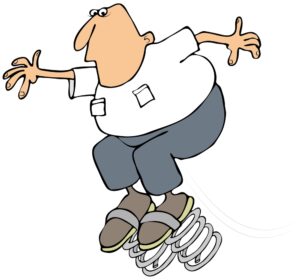We know many of you have been digging in and learning more about digital marketing and how to maximize leads from your senior living websites during the pandemic. Site bounce rate has been generating a lot of questions.
Because we know not everyone is familiar with the term… here’s the quick scoop on what that term means. Then we’ll chat about ways to improve yours.

What the Heck Is a Bounce Rate?
Google uses the term bounce rate to refer to the number of single page visitors that come to your site. Essentially, it means the visitor stayed on the same page they landed on and didn’t prowl around your site.
In some cases, it can be easily explained and not a bad thing.
For example, let’s say an adult daughter wants to check to make sure you offer assisted living before she calls to schedule a virtual tour. She googles your community name along with assisted living. Clicks on the search engine result and Bam! She’s on your assisted living page. That’s all she needed so she logs off to call you.
Many other times, however, a high bounce rate means your senior living website is delivering a poor visitor experience.
A visitor might land on your site with hopes of getting answers or information but hop off quickly for a variety of reasons.
What are some of the common reasons visitors are bouncing? Let’s explore a few you can easily work on while the COVID-19 crisis is keeping many marketing teams stuck inside.

Improving Your Senior Living Site’s Bounce Rate
- Load time: Let’s face it, most of us are pretty impatient these days. In the line at the grocery store, at stop lights, and especially online. If your site doesn’t load quickly, visitors bounce back to the search engine results and try someone else. How quick is quick, you might be asking? You literally only have a few seconds to get your site in front of a visitor. As the number of mobile visitors grows, that time keeps getting shorter.
- Hot mess: We see this more with home care sites, but still come across it with senior living providers too. The site is busy-looking or cluttered. Fonts are disagreeable looking or too small. Navigation isn’t clear. Menus are imprecise or missing. People want to be able to find their way around your site easily. Visitors are outta there if they can’t.
- Overwhelming content: Our clients all know this, but we’ll share it for those who don’t. We break a ton of rules when we write content and deliver it on SEO ready templates. Shorter sentences. Paragraphs with fewer sentences. Generous use of bold and italics. Bulleted lists and checklists. Images. We break copy up so the visitor’s eye isn’t overwhelmed when they land on client pages. That style of content keeps visitors on the site longer.
- Internal links: Using anchor text to link copy in new articles to relevant posts or to related places on your site also helps your bounce rate. For example, if you are writing an article on lowering cholesterol for your independent living blog, you might be referencing the Blue Zone diet. If you’ve previously written about those areas around world, link to that article. Or you could link to a page on your site where you outline your dining services program’s approach to good nutrition. (Total sidebar: have you heard about the Blue Zones? Check them out here and your body will thank you.)
- Relevant keywords: Does your site rank well for the most important, relevant keywords? When your site matches your searcher’s intent, they’ll visit longer. The reverse is also true. If you are deliberately or inadvertently ranking high for unrelated keywords, your audience will bounce. For example, our site is Senior Care Content Specialists. For a while, we were ranking at the top of the first page when people were looking for senior care managers. Many people would email us for help without even looking at our site because they assumed that’s what we did. It took a concentrated effort to turn that around.
And one final tip…
Check your Google Analytics or ask your web crew to review them with you on a regular basis. How long are people staying on your site? Is that improving or getting worse? How many pages are they visiting? Which articles or pages are getting the most traffic?
This review will give you a better idea about what visitors are really looking for and what pages/articles might need some finesse.
Questions?

As always, drop us a line if you have any questions about strategy or content for your independent, assisted living, or memory care website. Ditto for home care agencies and other aging services providers.
Until next time,